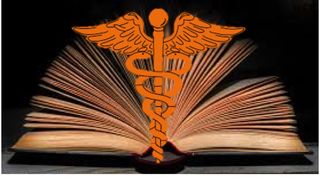Depression
Bibliotherapy: Using Books to Help and Heal
New research supports an ancient practice.
Posted October 1, 2019 Reviewed by Abigail Fagan

As the word suggests, bibliotherapy combines two of our favorite topics – reading and psychology – so it seemed a particularly appropriate topic to highlight in this post.
The term itself was coined only about a century ago by Samuel Crothers, a Unitarian minister who wrote an article in the Atlantic Monthly describing how relevant books could be used as an effective adjunct to medical or psychological treatment. However, the idea of bibliotherapy has existed from ancient times. The library at Thebes in ancient Greece had written over its door, “Healing place of the soul,” and people have always instinctively recognized the power of stories to not only entertain and inform but also to comfort and guide.
What Is Bibliotherapy?
Bibliotherapy is most easily defined as facilitating psychological growth and healing through reading. Most people in the field recognize two distinct branches of bibliotherapy, though the exact dividing line between them is not easily drawn.
Developmental bibliotherapy is used mainly in community or educational settings, to help children or adults address common life issues. For example, Gregory and Vessay explain how school nurses can help children address issues of bullying through bibliotherapy, while a 2006 study by Frieswijk et al. demonstrated how bibliotherapy can positively affect self-care behaviors in somewhat frail, community-living seniors, thus decreasing their probability of future institutionalization.
Clinical or therapeutic bibliotherapy is the use of books in a professional therapy context to treat a diagnosed emotional disorder or ameliorate the negative life impact of a diagnosed emotional, mental or physical disorder. Therapeutic bibliotherapy is most often used as an adjunct to more traditional medical or psychological therapies, as in a just-reported study that successfully used poetry therapy to reduce anxiety and PTSD in patients recovering from a heart attack.
But it can be used as a stand-alone therapy as well, as it was in a 2004 study that compared the effectiveness of self-administered bibliotherapy with traditional short-term (12-20 sessions) psychotherapy for 60 older adults diagnosed with depression, and found both were equally effective in reducing clinician’s ratings of depression, both immediately post-treatment and at a three-month follow-up.
How Is It Done?
Bibliotherapy is more of a general concept than a single, rigorously defined therapeutic method. As in the final example cited above, bibliotherapy can sometimes be as simple as “prescribing books” — that is, telling a student, client, or patient to read a particular book that you believe will help them. More often, bibliotherapy is facilitated through interaction with a helper or guide, either one-on-one, as in a counseling situation, or in a group of people who are dealing with similar issues and reading and responding to a text together.
The pioneering work of Sadie Peterson Delaney with World War I veterans at the VA Hospital in Tuskegee is an excellent example of both types. Delaney was a librarian by training, but bibliotherapy can also be successfully facilitated by many other helping professionals, including doctors, psychologists, social workers, school counselors, teachers, and community workers.
One can even practice bibliotherapy on oneself, as we suspect many avid readers do, returning to favorite books that they know will lift their spirits when life looks generally grey, or, more urgently, seeking written advice or inspiration to help them face significant life challenges, such as a cancer diagnosis or the loss of a loved one. Indeed, therapeutic texts can be of many different types: Narrative fiction is the original and traditional genre used in bibliotherapy, with poetry a close second, but self-help books are now just as popular, while biographies and memoirs can also be very helpful if written by or about someone who struggled with or triumphed over circumstances similar to those readers face.
Of course, therapeutic texts need not be complete books; short stories have been found effective in bibliotherapy, especially with participants whose attention span may be limited by age or cognitive impairment, while several practitioners have written about using comic books, and both teachers and therapists often use picture books to help young children develop and cope with difficult circumstances.
How Does It Work?
There is much discussion in the theoretical literature on bibliotherapy about whether its beneficial effects derive from the actual reading of the text itself or from the interaction, discussion, and sharing around the text that typically accompanies that reading. It seems likely the answer is both.
But most people in the field agree that the process works through the familiar therapeutic stages of identification, catharsis, and insight. In the first stage, the reader forms an affiliation with a character or characters in the text, identifying with their problems and goals. Catharsis comes about as the reader follows the characters through the text, experiencing from a safer, once-removed position their emotions, struggles, and hopes as they work toward the eventual resolution. Insight is the conscious recognition of similarities between the characters or situations in the text and the reader’s own characteristics and circumstances, and the subsequent decision to apply ideas or lessons from the text to the reader’s own thoughts and actions.
Many scholars add a fourth stage, universalization, in which the text helps readers realize that they are not alone, but that many others share similar problems and concerns and have found ways to deal with them. In this respect, bibliotherapy, even if undertaken alone or one-on-one, offers an important benefit more often associated with group therapy.
Who Can It Help?
Professional articles about bibliotherapy have tended more toward the anecdotal, recounting individual case studies or describing how a particular program or practitioner makes use of bibliotherapy. But some studies using experimental and quasi-experimental methods have found statistically significant evidence of the effectiveness of bibliotherapy with such disparate populations as depressed adults, children with internalizing and externalizing disorders, and perfectionists.
The number of such rigorous studies is gradually growing, and 2019 looks to be the “year of bibliotherapy” — a number of studies have been published just this year on the use of bibliotherapy with refugee children who have suffered trauma, children with intellectual disabilities, victims of sexual abuse, adults with dementia, children with OCD, and pre-service teachers.
If you want to know more about this growing field, which combines traditional aspects of literature – character, theme, emotion, and plot — with therapeutic functions more often ascribed to clinical psychology, here are a few good places to start:
- The National Association for Poetry Therapy and the Journal of Poetry Therapy, which they publish and which looks at bibliotherapy with all types of texts, not just poetry.
- Davis, C. A. G. (2019). ‘Why Bibliotherapy?’ A Content Analysis of its Uses, Impediments and Potential Applications for School Libraries. Qualitative and Quantitative Methods in Libraries, 75-93.
- Hynes, A. M. (2019). Bibliotherapy: The Interactive Process. A Handbook. Routledge.




